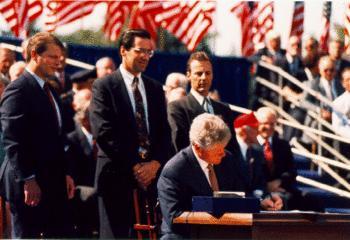
English: President Bill Clinton signing the North American Free Trade Agreement into Law. Al Gore is pictured besides him. (Photo credit: Wikipedia)
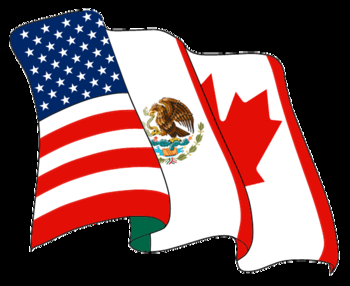
English: A North American Free Trade Agreement (NAFTA) Logo. Español: Logotipo del Tratado de Libre Comercio de América del Norte (TLCAN). Français : Logo de Accord de libre-échange nord-américain (ALENA). (Photo credit: Wikipedia)

Protectionism-FAIL (Photo credit: Dakiraun)
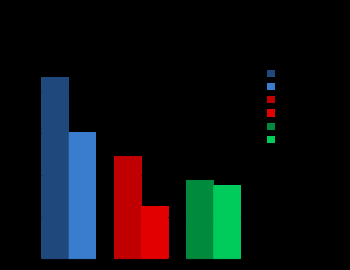
Outcome of union elections based on threats to move plants because of NAFTA. (Photo credit: Wikipedia)
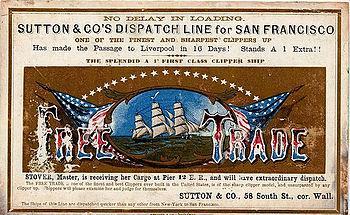
Free Trade clipper ship (Photo credit: Wikipedia)
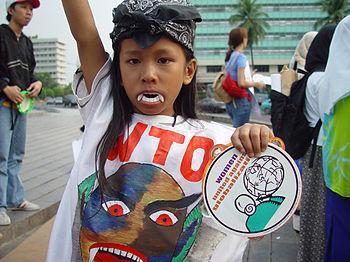
Some people do not see international trade favourably: here a child protests against the WTO in Jakarta. (Photo credit: Wikipedia)

United States Petroleum Imports in 2007 (Photo credit: Wikipedia)
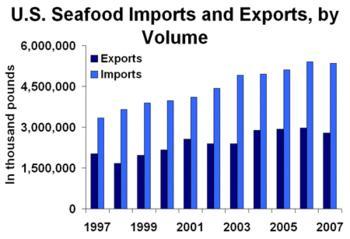
English: Graph of U.S. seafood imports and exports 1997–2007. (Photo credit: Wikipedia)
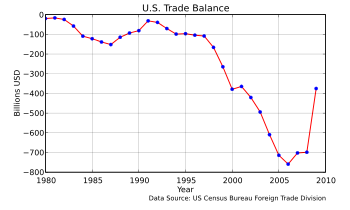
English: United States Balance of Trade, 1980–2009. Data Source: US Census Bureau Foreign Trade Division: http://www.census.gov/foreign-trade/statistics/historical/gands.txt (Photo credit: Wikipedia)

Jakarta WTO protest2 (Photo credit: Wikipedia)
Here’s my Pinterest Trade Board http://www.pinterest.com/socialmediaevie/trade/
There are many theoretical benefits of trade. However, national government officials do not always embrace the concept. National governments continue to protect all or some of their industries using a myriad of tactics.
The global trading system through the World Trade Organization (WTO) tries to balance national desires for protectionism and international desires for free trade.
Free trade is a policy in international markets and also a pattern of exports and imports without trade barriers; governments do not restrict imports or exports. Free trade is the pattern of imports and exports that would result in the absence of trade barriers.
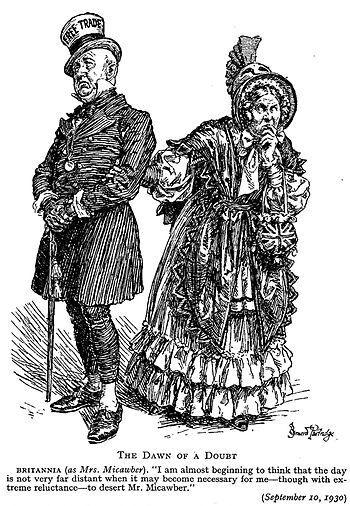
Punch cartoon, 1930: The character on the right represents a skeptical Britain becoming increasingly protectionist and dissatisfied with its Free Trade policies, as represented by the Micawber character to the left, during the Great Depression. (Photo credit: Wikipedia)
There are many reasons why a government would intervene in trade. Governments impose trade restrictions for economic, political and/or cultural reasons. Many governments impose some protectionist policies that are intended to support local employment, such as applying tariffs to imports or subsidies to exports. Governments may also restrict free trade to limit exports of natural resources. Other barriers that may hinder trade include import quotas, taxes, and non-tariff barriers, such as regulatory legislation.
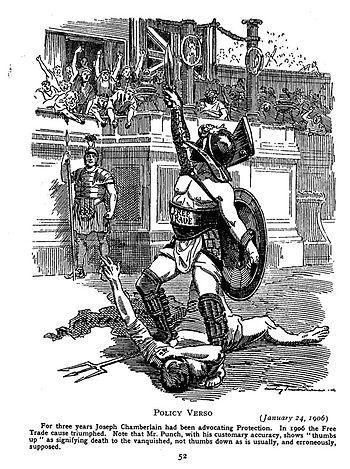
Punch cartoon (1906); Free Trade triumphs over Protectionism as policies favoring free trade were adopted throughout the British Empire. (Photo credit: Wikipedia)
Proponents of free trade spawned the 28 member European Union. The European Union (EU) is an economic and political union of the 28 member states

- Agriculture subsidy, from a Congressional Budget Office report. (Photo credit: Wikipedia)
The North American Free Trade Agreement (NAFTA) was also supported by free-trade advocates. NAFTA is an agreement signed in 1994 by Canada, Mexico, and the United States, creating a trilateral rules-based trade bloc in North America.
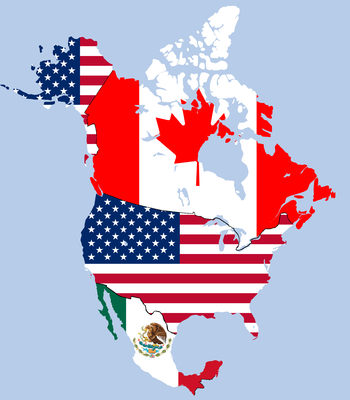
English: Map of the Tratado de Libre Comercio (TLC or NAFTA in English) (Photo credit: Wikipedia)
Most nations are members of the World Trade Organization (WTO) multilateral trade agreements. However, most governments still impose some protectionist policies.
Some of the political motives for protectionist policies include: job protection that lowers unemployment numbers and also preservation of “National Security Industries” in an effort to protect imports and exports for security including defense-related goods like military uniforms, weapons and missiles.
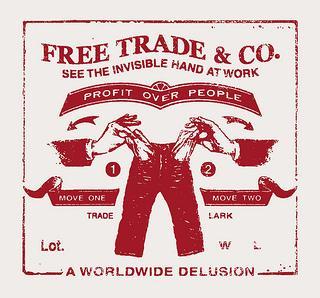
FREE TRADE 2006 (Photo credit: CHRISTOPHER DOMBRES)
Many countries fiercely protect their agricultural sector for national security reasons because a nation that imports its food supplies could face starvation in times of war.
Governments have mechanisms to respond to “Unfair” Trade Practices. They may threaten to close their ports or to impose high tariffs if another nation does not concede on a certain trade issue.
Some of the economic motives that governments deploy include: protecting innovative “Infant” and emerging industries during their development phase so they can become efficient and competitive.
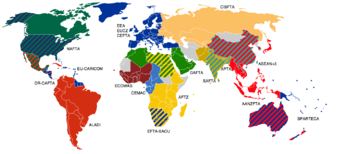
English: Free trade areas are a difficult subject. It is impossible to map all the existing free trade agreements on one map, and still make it readable. Here are presented FTAs with three or more participants. (Photo credit: Wikipedia)
Cultural motives to restrict trade are concerned with unwanted cultural exposure and influence “to people and products of other countries that could potentially slowly alters cultural beliefs.” Many countries have laws that protect their media and entertainment programming for cultural reasons.
The government also has methods for promoting trade. They can offer a subsidy; financial assistance to domestic producers in the form of low-interest loans, tax breaks or cash payments to help domestic companies protect themselves from international rivals. The government can also offer export financing through loans and loan guarantees. U.S. companies can obtain export financing from the Export-Import Bank and the Overseas Private Insurance Corporation (OPIC). “OPIC insures against losses due to: (1) expropriation, (2) currency inconvertibility, and (3) war, revolution, and insurrection.”
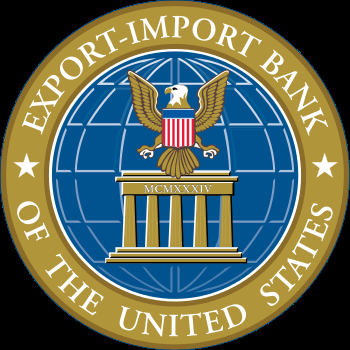
Seal of the Export-Import Bank of the United States. (Photo credit: Wikipedia)
Foreign trade zones minimize problems associated with exports because the intervention of the customs authorities is reduced.” Goods are allowed to pass through with lower customs duties and fewer customs procedures and administrative delays which are regulatory controls or bureaucratic rules designed to impair the rapid flow of imports into a country.
These Foreign-trade zones are organized around major seaports, international airports, and national frontiers. Customs duties increase production costs and delay delivery time. Companies can reduce such costs and time by establishing a facility inside a foreign trade zone.
China has established very large foreign trade zones. Mexico’s maquiladora zones are similar to foreign trade zones because they import materials from the United States and then process them and re-export them to the United States. Duties are only computed on the value added in Mexico.
Governments have special agencies responsible for promoting exports and frequently organize trips for trade officials and business representatives to visit other countries.
There are many ways to restrict trade. A tariff is a trade-restricting government tax levied on a product as it enters or leaves a country. There are 3 basic types of tariffs: (1) export tariff, (2) transit tariff, and (3) import tariff.
An ad valorem tariff is an import tariff levied as a percentage of the stated price of an imported product. A specific tariff is levied as a specific fee for each unit (by number or weight) of an imported product. A compound tariff is calculated partly as a percentage of the stated price of an imported product, and partly as a specific fee for each unit. Because import tariffs raise the cost of an imported good, domestically produced goods appear more attractive to buyers. Tariffs generate revenue for the government. As countries develop, they generate a greater portion of their revenues from taxes on income, capital gains, and other economic activities; as opposed to generating revenue from tariffs.
A quota is a restriction on the amount of a good that can enter or leave a country during a certain period of time. Governments administer quota systems by granting quota licenses to other nations’ companies or governments (import quotas) and domestic producers (export quotas). Import Quotas protect domestic producers by placing a limit on the amount of goods entering the country. This helps domestic producers maintain market share and protect profit margins. Domestic producers gain in this scenario because of market protection, but consumers lose because they must pay higher prices and have limited selection because there is less competition.
A voluntary export restraint (VER) is a unique version of export quota that a nation imposes on its exports, usually at the request of an importing nation. Export quotas hurt consumers in the importing nation because of reduced selection and higher prices. Export quotas might help retain jobs if foreign imports threaten to put domestic producers out of business. Japanese car manufacturers have used VER.
An embargo is a complete ban on trade in one or more products with a particular country. It may be placed on one or a few goods or completely ban trade in all goods. It is the most restrictive nontariff trade barrier and often has political goals. The US has an embargo with Cuba. Embargoes can be decreed by individual nations or by organizations like the UN.
Local Content Requirements are laws “stipulating that producers in the domestic market must supply a specified amount of a good or service. They are designed to force companies from other nations to employ local resources in their production processes including labor.” These requirements mwage countries.
Currency Controls are restrictions on the convertibility of a currency into other currencies. Governments can reduce imports by mandating an exchange rate that is unfavorable to potential importers or enhance exports with more favorable rates.
The Global Trading system has evolved over time. World trade peaked in the late 1800s. The U.S. enacted the Smoot-Hawley Act in 1930 which shifted the national sentiment from free trade to protectionism. Smoot-Hawley launched global trade wars and prolonged the Great Depression.
In 1947, the General Agreement on Tariffs and Trade (GATT) treaty was designed to promote free trade by reducing both tariff and nontariff barriers to international trade. It eventually became the World Trade Organization that regulates trade among nations. The 3 main goals of the WTO are: (1) encourage freer trade; (2) negotiate opening of markets; and (3) settle trade disputes. WTO absorbed the GATT agreements into its own agreements. WTO agreements are “contracts among member nations that commit them to maintaining fair and open trade policies.” When “a member files a complaint, the Dispute Settlement Body of the WTO renders a decision in less than one year. Offenders must realign policies according to WTO guidelines or suffer financial penalties and perhaps trade sanctions.” The WTO gets involved in settling disputes that involve “dumping” and the granting of subsidies. Dumping occurs when a company exports a product at a price that is either lower than the price normally charged in its domestic market, or lower than the cost of production. The WTO allows a nation to “retaliate against dumping if it proves dumping charges, calculates the damage, and can show the damage is significant. Nations retaliate by imposing an antidumping duty—an additional tariff placed on an imported product that a nation believes is being dumped on its market.”
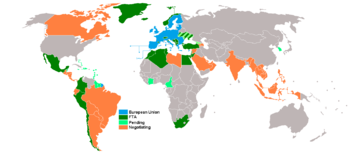
English: EU and free trade agreements countries (Photo credit: Wikipedia)



COMMENTS ( 3 )
posted on 16 January at 14:04
This is very interesting, You're a very professional blogger. I have joined your rss feed and stay up for in search of more of your wonderful post. Additionally, I've shared your web site in my social networks
posted on 14 January at 16:43
Hello friends, nice post and good arguments commented at this place, I am truly enjoying by these.
posted on 02 December at 00:09
I pay a visit every day a few websites and sites to read articles, except this webpage provides quality based articles.